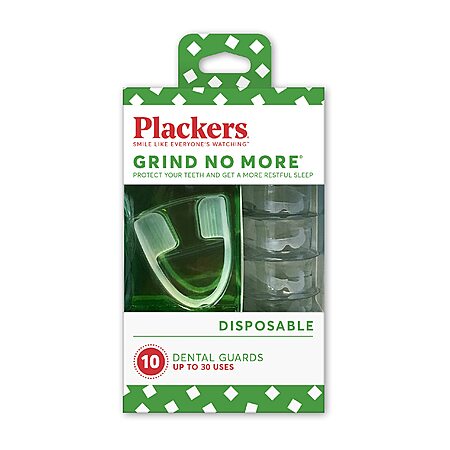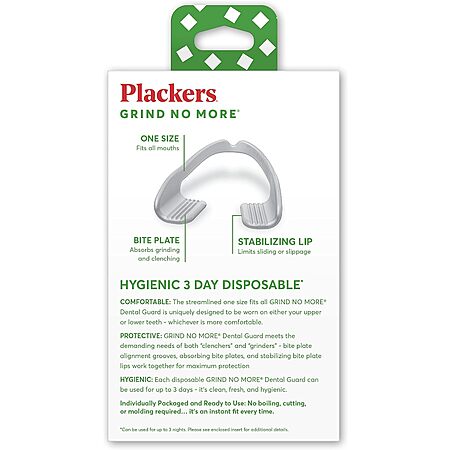Amazon has
10-ct Plackers Grind No More Ready to Wear Disposable Night Guard on sale for
$5.64 when you clip the 20% off coupon on the item page and check out via Subscribe and Save.
Shipping is free w/ Prime or on $35+ orders.
- Note: You may cancel Subscribe & Save any time after your order ships. Must be logged in to clip coupons; coupons are typically limited to one per account.
Thanks to community member
MusicShark for finding this deal.
Features:- Featuring patented clench and grind absorbing bite plates to stop you from grinding your teeth during the night and to increase peaceful sleep
- Each disposable Plackers dental night guard is BPA free and is not made with natural rubber latex and is completely hygienic with use up to 3 days
- Plackers grind no more night guards are individually packaged and ready to wear as soon as you receive them with no boiling, cutting or molding required




Leave a Comment
Top Comments
What dentists hate are patients that don't treat their bruxism, develop the need for full mouth restoration, and then complain that they need a lot of dentistry while wanting some magical low-cost repair. Wear the nightguard and pay a fair price for another dentist, and they won't care about which nightguard you use if the attrition stops.
The trouble with trying to tell anything from your statement is we don't know if you encountered three bad dentists (which I would believe would be highly unlikely unless you are a cheapskate going to a corporate practice like Aspen for "free exams") or if you could be correctly diagnosed by three dentists and still incapable of understanding why. We just can't tell. You likely don't even know if you have posterior or canine guidance, but you believe you are armed with the information to state emphatically that those three other people are wrong and/or unethical.
You missed the point that these, and similar bruxism devices, are typically in the $20-30 range at Walgreens. These can be good, some boil and bites can work, and custom occlusal guards can too. The number one factor is compliance - it has to actually be worn.
1.) Prevalence of bruxism is far and away highest in children and is generally self limiting.
2.) If you have significant wear from bruxism, you also have a problem with acid.
3.) People with bruxism are far more likely to also have sleep apnea.
4.) A large neck is associated with bruxism.
50 Comments
Sign up for a Slickdeals account to remove this ad.
Our community has rated this post as helpful. If you agree, why not thank Selman
What dentists hate are patients that don't treat their bruxism, develop the need for full mouth restoration, and then complain that they need a lot of dentistry while wanting some magical low-cost repair. Wear the nightguard and pay a fair price for another dentist, and they won't care about which nightguard you use if the attrition stops.
So what exactly is better about the Walgreens $30 version vis-à-vis this $1 version?
The trouble with trying to tell anything from your statement is we don't know if you encountered three bad dentists (which I would believe would be highly unlikely unless you are a cheapskate going to a corporate practice like Aspen for "free exams") or if you could be correctly diagnosed by three dentists and still incapable of understanding why. We just can't tell. You likely don't even know if you have posterior or canine guidance, but you believe you are armed with the information to state emphatically that those three other people are wrong and/or unethical.
You missed the point that these, and similar bruxism devices, are typically in the $20-30 range at Walgreens. These can be good, some boil and bites can work, and custom occlusal guards can too. The number one factor is compliance - it has to actually be worn.
Sign up for a Slickdeals account to remove this ad.
Despite advertised as disposable, you really don't need to replace them often at all. I have been wearing the same $1 unit for probably a year now. I have a glass of water with a few drops of bleach next to the bed that I drop the nightguard it in each morning.
I previously had a custom nightguard from a dentist that cost something like $300, for a simple molded piece of plastic. But it was uncomfortable and would often wind up out of my mouth, maybe even across the room in the morning.
Dentists HATE these because they are so simple, so cheap and don't require any "fitting". But based on my experiences, after having mentioned these to 3 different dentists over the years, that they will try strongly to dissuade you from using one with all sorts of nonsense FUD.
What dentists hate are patients that don't treat their bruxism, develop the need for full mouth restoration, and then complain that they need a lot of dentistry while wanting some magical low-cost repair. Wear the nightguard and pay a fair price for another dentist, and they won't care about which nightguard you use if the attrition stops.
1.) Prevalence of bruxism is far and away highest in children and is generally self limiting.
2.) If you have significant wear from bruxism, you also have a problem with acid.
3.) People with bruxism are far more likely to also have sleep apnea.
4.) A large neck is associated with bruxism.
What dentists hate are patients that don't treat their bruxism, develop the need for full mouth restoration, and then complain that they need a lot of dentistry while wanting some magical low-cost repair. Wear the nightguard and pay a fair price for another dentist, and they won't care about which nightguard you use if the attrition stops.
I got a few different one made by my dentist but anything bigger than 1mm I just can't stand it. Now days I get the ~$120 bucks one from Amazon (Encore brand) where they sent you the material to made a mold to sent to them to make one. It's almost identical to the one I get from my dentist.
Speaking of Aspen, I still remember when I visited them many many years ago. Had this "office manager" sit down with me to go over "my treatment plan". Entire thing felt like dealing with used car sales. I left and never gone back. Ended up asking around at work for recommendation.
I got great dentist now who I found through recommendation of my local dental society. I found that in every profession there are people who really are "geeks" vs some who just want to collect a paycheck and I'm glad I found "dental geek".
What likely happened with your daughter is that she already had cavities. They were lesions between her teeth called "Class II" lesions. They weakend the ridges on the side of the tooth, and the grinding broke off the enamel so you could see them. Don't feel bad, dentists can't even see most small Class II lesions. That's why xrays exist.
My advice is to decrease the intake of fermentable carbs (e.g. juice and crackers), increase water as the primary drink, brush at least 4 minutes per day with anticavity toothpaste, and see a dentist for periodic check up to catch potential lesions earlier. The only stop gap now is reducing sugar and remineralizing the teeth as much as possible with anticavity toothpaste until she can get in. If she gets in with a pediatric dentist, I strongly advise maintaining that relationship as children who don't have much dental experience prior to their first cavity can be more difficult to treat.
I'm glad your little girl isn't hurting, but if you can see the cavity then it's massive. Don't be alarmed if she needs a "baby tooth root canal" (pulpotomy) and a crown. If you see one overt cavity, there's very likely multiple others. We are blessed with a second set, and that baby molar will be replaced at about 9-11 years old. It's all going to be okay, and we just take it as a chance to learn since the permanents are starting to come in right now.
My problem is, if the thing forces my mouth to remain open then my mouth dries out quickly and that makes it a lot more difficult for me to fall asleep.
If I can keep my mouth shut while wearing these, great! Will report back. Thank you OP for the find! Thank you Selman, for the helpful info as well!
Sign up for a Slickdeals account to remove this ad.
What happened with your daughter is that she already had cavities. They were lesions between her teeth called "Class II" lesions. They weakend the ridges on the side of the tooth, and the grinding broke off the enamel so you could see them. Don't feel bad, dentists can't even see most small Class II lesions. That's why xrays exist.
My advice is to decrease the intake of fermentable carbs (e.g. juice and crackers), increase water as the primary drink, brush at least 4 minutes per day with anticavity toothpaste, and see a dentist for periodic check up to catch potential lesions earlier. The only stop gap now is reducing sugar and remineralizing the teeth as much as possible with anticavity toothpaste until she can get in. If she gets in with a pediatric dentist, I strongly advise maintaining that relationship as children who don't have much dental experience prior to their first cavity can be more difficult to treat.
I'm glad your little girl isn't hurting, but if you can see the cavity then it's massive. Don't be alarmed if she needs a baby tooth root canal (pulpotomy) and a crown. If you see one overt cavity, there's very likely multiple others. We are blessed with a second set, and that baby molar will be replaced at about 9-11 years old. It's all going to be okay, and we just take as a chance to learn since the permanents are starting to come in right now.
Leave a Comment